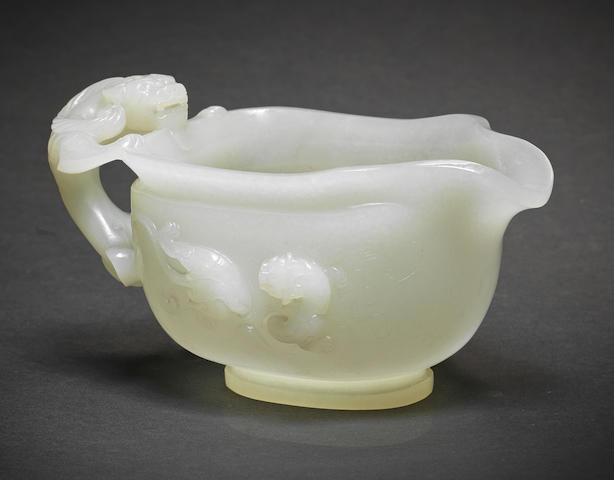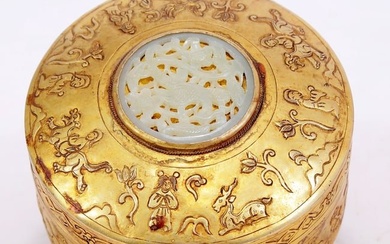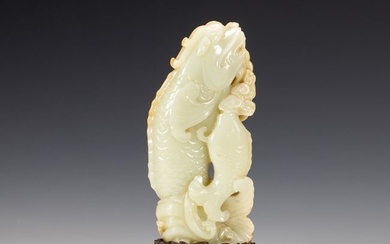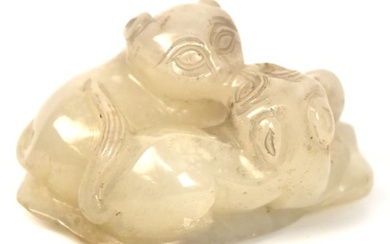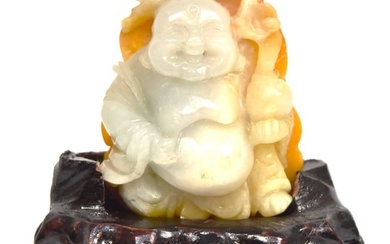A FINE AND RARE WHITE JADE 'DRAGON AND YOUNG' POURING VESSEL, YI
Qianlong
Qianlong
The deep rounded sides carved with a pouring lip to one end and a chilong handle to the other clambering up the side of the vessel, with its head resting at the rim, the sides carved in high relief with sinuous, striding chilong amongst incised wispy clouds, the lustrous stone of white even tone. 14cm (5 1/2in) long.
清乾隆 白玉雕蒼龍教子匜
Provenance:
Spink & Son Ltd., London
Parry Collection, London, and thence by descent
來源:
倫敦古董商Spink & Son Ltd.
倫敦Parry家族收藏,並由後人保存迄今
Notable for its exceptionally lustrous white jade and highly refined high relief carving of sinuous chilong clambering its elegant body, the present pouring vessel counts amongst the finest jade carvings made during the celebrated reign of the Qianlong Emperor. The exceptional purity of the jade, particularly visible in the areas left unadorned, smoothly polished to a lustrous sheen, here combines with the archaistic style favoured by the Qianlong Emperor and the masterful ingenuity of craftsmanship and design.
In form and design, the present vessel is inspired by the archaic bronze water pouring vessel, yi, which was often used in conjunction with a pan for the ritual washing of hands. It was a late Western Zhou adaptation of the gong and the he vessels, and its use continued well into the Eastern Zhou period; see a bronze pouring vessel, yi, Western Zhou dynasty, cast with clambering chilong, illustrated by J.Rawson, The Bella and P.P. Chiu Collection of Ancient Chinese Bronzes, Hong Kong, 1988, pl.31. At the same time, the depictions of sinuous chilong displaying curled and bifurcated tails is inspired by the jade carving style of the Han dynasty; see a jade scabbard chape, Han dynasty, carved with a pair of chilong illustrated by J.Rawson, Chinese Jade From the Neolithic to the Qing, London, 1995, p.299, no.21:9.
The Qianlong Emperor's appreciation of jade, expressed through more than eight hundred of his writings, combined with his passion for antiques, resulted in his commissioning significant numbers of archaistic jade carvings for his Court. The Emperor advocated taking inspiration from antiquity in form and design to 'restore the ancient ways', or the intrinsic values of harmony, simplicity and happy exuberance. In a poem entitled 'The Ballad on a Cup of Jade', composed during the eighth year of his reign (1743), the Emperor maintained the importance of appreciating jade as a genuinely personal path towards virtue. The Emperor instructed the Court to collect drawings of antiquities, such as the Xi Qing Gu Jian (Catalogue of Xiqing Antiquities). To fulfill the Emperor's ambitious project therefore, the artisans working at the Imperial Ateliers and in jade workshops in Suzhou were encouraged to carefully study the remarkable archaic bronzes in the Court collection or woodblocks depicting such antiques to draw inspiration for their new creations; see Chang Li-tuan, The Refined Taste of the Emperor: Special Exhibition of Archaic and Pictorial Jades of the Ch'ing Court, Taipei, 1997, pp.49-50.
The exceptional quality of the white jade stone which was used to produce this vessel would have become more available for the Jade Workshops following the Qianlong Emperor's conquest of the Dzungar Khanate between 1755 and 1759, where much of the jade was sourced. The jade carver, whilst demonstrating his skills in the form and relief carving, ensured that the magnificent quality of the stone would be exhibited through the areas left unadorned. The present vessel therefore encapsulates the Qianlong Emperor's personal taste for antiquity in form and design, combined with the superb jade material.
A related white jade archaistic pouring vessel yi carved with clambering chilong, Qianlong, in the Musée National du Chateau de Fontainbleu, France, is illustrated in Jade: From Emperors to Art Deco, Paris, 2016, p.238, no.192.
白玉琢制,圓身深腹,柄以攀爬於口沿之上的一尾螭龍為飾,流口位置與螭龍柄相對。雙浮雕螭龍分飾盃身兩側,穿行於縷雲之間。
本例可謂乾隆年間玉雕器皿之佼佼者。其玉色光潔,精巧雕工在優雅蜿蜒的龍身上尤為突出。玉質之純淨在精心打磨過的素面之處表露無遺。除其精湛玉工外,該匜亦融合了乾隆皇帝所推崇的復古風格。
該器以古代青銅匜為濫觴。後者在上古時代常與青銅盤搭配,於儀禮上供濯洗之用。盤匜搭配作為儀禮水器的使用方式興自西周,匜器也逐漸取代了之前流行的注水器如觥、盉等,並一直延續到東周時期。以螭龍紋為飾的西周青銅匜,可見於J.Rawson著,《The Bella and P.P. Chiu Collection of Ancient Chinese Bronzes》,香港,1988年,圖版31。本例玉匜上的螭龍形象則可能源於漢代,參見一例漢螭龍紋玉劍珌,收錄於J.Rawson著,《Chinese Jade From the Neolithic to the Qing》,倫敦,1995年,頁299,編號21:9。
乾隆皇帝筆下有八百多篇詠玉的詩文,足見其對這種材質之喜愛珍重。加上他對古物的追慕之情,當時宮廷內按其交辦所製之復古風格玉雕數目龐大。乾隆一生以「復古」為念,更在作於乾隆八年(1743年)的御製文《玉盃記》中以玉工所言煉玉之法比之於君子之道,並直言「執藝以諫者,古典所不廢」讚賞玉工之德。乾隆帝曾於其在位年間,諭令編纂《西清古鑑》以著錄清宮所藏古物。為滿足其復古趣味,內府工匠及被徵調而來的蘇州玉工在製作御用器皿之時,亦常以內廷所藏古代銅器及金石版畫為參考,詳見張麗端著,《宮廷之雅——清代仿古及畫意玉器特展圖錄》,台北,1997,頁49-50。
1755-1759年,乾隆皇帝平定準葛爾部,優質玉石原料源源不斷貢入清廷。而工匠在炫耀鬼斧神工之餘,也充分確保玉石與生俱來的特質與光澤能通過打磨在無雕飾之處充分展現出來。由此,本例無論造型還是雕工,都實為乾隆皇帝個人復古品味與上佳玉石品質之結合。
參考位於楓丹白露宮的法國國家博物館館藏一件清乾隆螭龍紋白玉匜,圖見《Jade: From Emperors to Art Deco》,巴黎,2016年,頁238,編號192。
View it on
Sale price
Estimate
Time, Location
Auction House
Qianlong
Qianlong
The deep rounded sides carved with a pouring lip to one end and a chilong handle to the other clambering up the side of the vessel, with its head resting at the rim, the sides carved in high relief with sinuous, striding chilong amongst incised wispy clouds, the lustrous stone of white even tone. 14cm (5 1/2in) long.
清乾隆 白玉雕蒼龍教子匜
Provenance:
Spink & Son Ltd., London
Parry Collection, London, and thence by descent
來源:
倫敦古董商Spink & Son Ltd.
倫敦Parry家族收藏,並由後人保存迄今
Notable for its exceptionally lustrous white jade and highly refined high relief carving of sinuous chilong clambering its elegant body, the present pouring vessel counts amongst the finest jade carvings made during the celebrated reign of the Qianlong Emperor. The exceptional purity of the jade, particularly visible in the areas left unadorned, smoothly polished to a lustrous sheen, here combines with the archaistic style favoured by the Qianlong Emperor and the masterful ingenuity of craftsmanship and design.
In form and design, the present vessel is inspired by the archaic bronze water pouring vessel, yi, which was often used in conjunction with a pan for the ritual washing of hands. It was a late Western Zhou adaptation of the gong and the he vessels, and its use continued well into the Eastern Zhou period; see a bronze pouring vessel, yi, Western Zhou dynasty, cast with clambering chilong, illustrated by J.Rawson, The Bella and P.P. Chiu Collection of Ancient Chinese Bronzes, Hong Kong, 1988, pl.31. At the same time, the depictions of sinuous chilong displaying curled and bifurcated tails is inspired by the jade carving style of the Han dynasty; see a jade scabbard chape, Han dynasty, carved with a pair of chilong illustrated by J.Rawson, Chinese Jade From the Neolithic to the Qing, London, 1995, p.299, no.21:9.
The Qianlong Emperor's appreciation of jade, expressed through more than eight hundred of his writings, combined with his passion for antiques, resulted in his commissioning significant numbers of archaistic jade carvings for his Court. The Emperor advocated taking inspiration from antiquity in form and design to 'restore the ancient ways', or the intrinsic values of harmony, simplicity and happy exuberance. In a poem entitled 'The Ballad on a Cup of Jade', composed during the eighth year of his reign (1743), the Emperor maintained the importance of appreciating jade as a genuinely personal path towards virtue. The Emperor instructed the Court to collect drawings of antiquities, such as the Xi Qing Gu Jian (Catalogue of Xiqing Antiquities). To fulfill the Emperor's ambitious project therefore, the artisans working at the Imperial Ateliers and in jade workshops in Suzhou were encouraged to carefully study the remarkable archaic bronzes in the Court collection or woodblocks depicting such antiques to draw inspiration for their new creations; see Chang Li-tuan, The Refined Taste of the Emperor: Special Exhibition of Archaic and Pictorial Jades of the Ch'ing Court, Taipei, 1997, pp.49-50.
The exceptional quality of the white jade stone which was used to produce this vessel would have become more available for the Jade Workshops following the Qianlong Emperor's conquest of the Dzungar Khanate between 1755 and 1759, where much of the jade was sourced. The jade carver, whilst demonstrating his skills in the form and relief carving, ensured that the magnificent quality of the stone would be exhibited through the areas left unadorned. The present vessel therefore encapsulates the Qianlong Emperor's personal taste for antiquity in form and design, combined with the superb jade material.
A related white jade archaistic pouring vessel yi carved with clambering chilong, Qianlong, in the Musée National du Chateau de Fontainbleu, France, is illustrated in Jade: From Emperors to Art Deco, Paris, 2016, p.238, no.192.
白玉琢制,圓身深腹,柄以攀爬於口沿之上的一尾螭龍為飾,流口位置與螭龍柄相對。雙浮雕螭龍分飾盃身兩側,穿行於縷雲之間。
本例可謂乾隆年間玉雕器皿之佼佼者。其玉色光潔,精巧雕工在優雅蜿蜒的龍身上尤為突出。玉質之純淨在精心打磨過的素面之處表露無遺。除其精湛玉工外,該匜亦融合了乾隆皇帝所推崇的復古風格。
該器以古代青銅匜為濫觴。後者在上古時代常與青銅盤搭配,於儀禮上供濯洗之用。盤匜搭配作為儀禮水器的使用方式興自西周,匜器也逐漸取代了之前流行的注水器如觥、盉等,並一直延續到東周時期。以螭龍紋為飾的西周青銅匜,可見於J.Rawson著,《The Bella and P.P. Chiu Collection of Ancient Chinese Bronzes》,香港,1988年,圖版31。本例玉匜上的螭龍形象則可能源於漢代,參見一例漢螭龍紋玉劍珌,收錄於J.Rawson著,《Chinese Jade From the Neolithic to the Qing》,倫敦,1995年,頁299,編號21:9。
乾隆皇帝筆下有八百多篇詠玉的詩文,足見其對這種材質之喜愛珍重。加上他對古物的追慕之情,當時宮廷內按其交辦所製之復古風格玉雕數目龐大。乾隆一生以「復古」為念,更在作於乾隆八年(1743年)的御製文《玉盃記》中以玉工所言煉玉之法比之於君子之道,並直言「執藝以諫者,古典所不廢」讚賞玉工之德。乾隆帝曾於其在位年間,諭令編纂《西清古鑑》以著錄清宮所藏古物。為滿足其復古趣味,內府工匠及被徵調而來的蘇州玉工在製作御用器皿之時,亦常以內廷所藏古代銅器及金石版畫為參考,詳見張麗端著,《宮廷之雅——清代仿古及畫意玉器特展圖錄》,台北,1997,頁49-50。
1755-1759年,乾隆皇帝平定準葛爾部,優質玉石原料源源不斷貢入清廷。而工匠在炫耀鬼斧神工之餘,也充分確保玉石與生俱來的特質與光澤能通過打磨在無雕飾之處充分展現出來。由此,本例無論造型還是雕工,都實為乾隆皇帝個人復古品味與上佳玉石品質之結合。
參考位於楓丹白露宮的法國國家博物館館藏一件清乾隆螭龍紋白玉匜,圖見《Jade: From Emperors to Art Deco》,巴黎,2016年,頁238,編號192。
